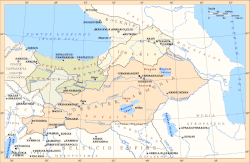
Back ساتراب أرمينيا Arabic هخامنشی ائرمنستان AZB Satrapia d'Armènia Catalan Arménie (satrapie) Czech Armena satrapio Esperanto Satrapía de Armenia Spanish ارمنستان (ساتراپی هخامنشی) Persian Սատրապական Հայաստան Armenian Kesatrapan Armenia ID სომხეთის სატრაპია Georgian
Satrapy of Armenia 𐎠𐎼𐎷𐎡𐎴 | |||||||||||||||||
|---|---|---|---|---|---|---|---|---|---|---|---|---|---|---|---|---|---|
| 570 BC–321 BC | |||||||||||||||||
 Territory of the Orontid dynasty in IV-II BC | |||||||||||||||||
| Status | Satrapy | ||||||||||||||||
| Capital | Tushpa Erebuni | ||||||||||||||||
| Common languages | Armenian Aramaic (South) Median (East) | ||||||||||||||||
| Religion | Armenian polytheism Zoroastrianism[1] | ||||||||||||||||
| Government | Monarchy | ||||||||||||||||
| King | |||||||||||||||||
| History | |||||||||||||||||
• Established | 570 BC | ||||||||||||||||
• Disestablished | 321 BC | ||||||||||||||||
| |||||||||||||||||
| History of Armenia |
|---|
 |
| Timeline • Origins • Etymology |
The Satrapy of Armenia (Old Persian: 𐎠𐎼𐎷𐎡𐎴 Armina or 𐎠𐎼𐎷𐎡𐎴𐎹 Arminiya), a region controlled by the Orontid dynasty (570–201 BC), was one of the satrapies of the Achaemenid Empire in the 6th century BC that later became an independent kingdom. Its capitals were Tushpa and later Erebuni.
- ^ Russell 1986, p. 51.